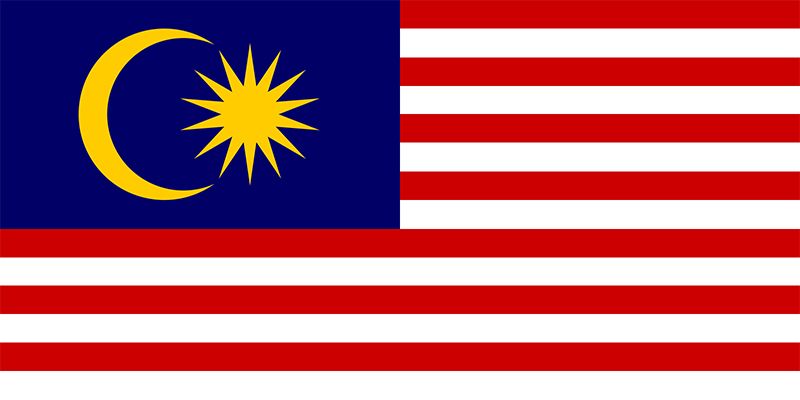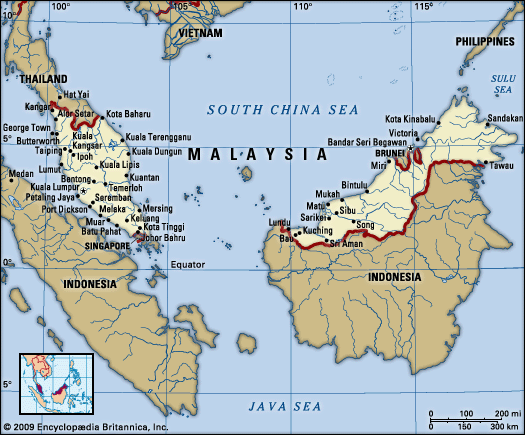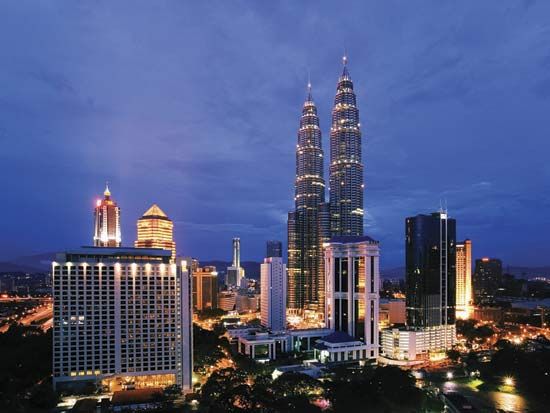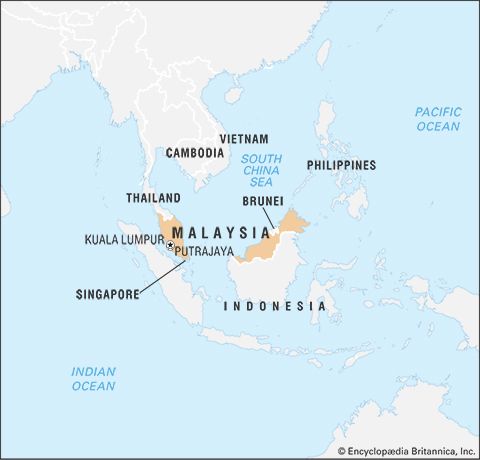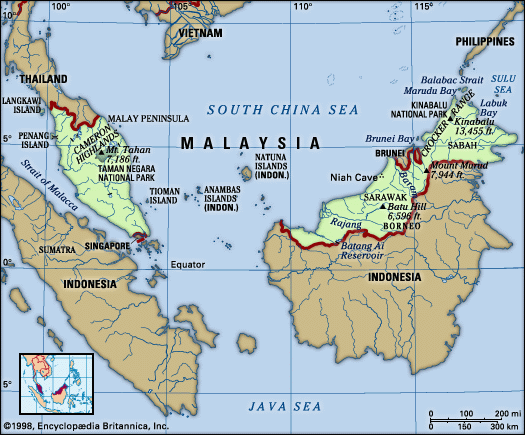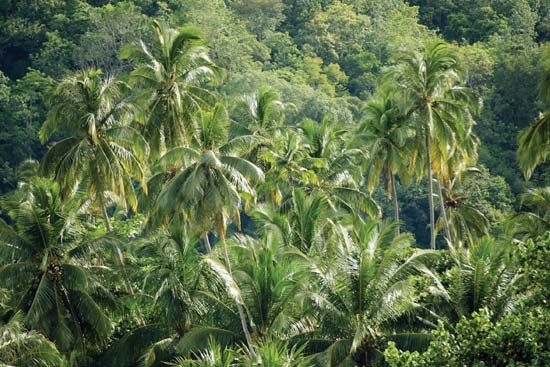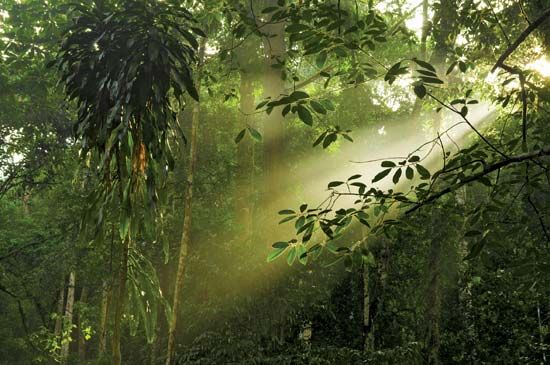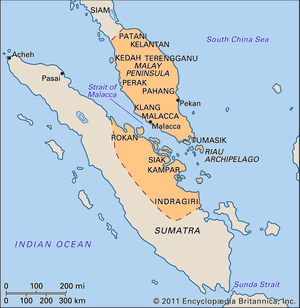Our editors will review what you’ve submitted and determine whether to revise the article.
News •
From the 13th through the 17th century, Sunni Islam, carried chiefly by Arab and Indian merchants, spread widely through peninsular and insular Southeast Asia. The new religion offered equal-opportunity social advancement through spiritual devotion, which ultimately challenged (but did not entirely eliminate) the power of the traditional elites; Islam also embodied a complex theology that held much appeal for farmers and merchants in the coastal regions. The dissemination of Islam was intimately linked to the florescence of the great Indian Ocean trading routes that connected China through the Strait of Malacca to India, the Middle East, and eastern Africa.
The arrival of Islam coincided with the rise of the great port of Malacca (now Melaka), established along the strait on Malaya’s southwest coast by Sumatran exiles about 1400. The Indianized king—who successfully sought a tributary relationship with powerful China—converted to Islam, becoming a sultan and hence attracting Muslim merchants. Soon Malacca became Southeast Asia’s principal trading entrepôt, while at the same time it gained suzerainty over much of coastal Malaya and eastern Sumatra. Malacca also served as the regional centre for the propagation of Islam and as the eastern terminus of the Indian Ocean trading network. Indonesian spices, Malayan gold, and Chinese silks and tea all passed through Malacca on their way to South Asia, the Middle East, and, ultimately, Europe. At its height in the late 15th century, Malacca hosted some 15,000 merchants of many nationalities, including Chinese, Arabs, Persians, and Indians; attracted by a stable government and a policy of free trade, the ships in the harbour purportedly outnumbered those in any other port in the known world. The Chinese admiral Zheng He called at the port several times in the first decades of the 15th century as part of the great naval expeditions of the Ming dynasty to the western Indian Ocean. Malacca’s political and religious influence reached its height under Tun Perak, who served as chief minister (1456–98) after defeating the expanding Siamese (Thai) in a fierce naval battle; during his tenure Islam became well entrenched in such districts (and subsidiary sultanates) as Johor (Johore), Kedah, Perak, Pahang, and Terengganu.
The mostly Islamicized people of 15th-century Malacca began calling themselves “Malays” (“Melayu”), likely a reference to their Sumatran origins. Thereafter the term Malay was applied to those who practiced Islam and spoke a version of the Malay language. Religious and linguistic behaviour, rather than descent, then, became the criteria for being Malay; this enabled previously Hindu-Buddhist peoples and former adherents of local religions to identify themselves (and even merge) with the Malays—regardless of their ancestry. Over time this loose cultural designation became a coherent ethnic group populating what is commonly called the “Malay world,” a region encompassing Malaya, northern and western Borneo, eastern Sumatra, and the smaller islands in between. Islam, however, came to overlay the earlier beliefs so that, before the rise of religious reform movements in the 19th century, few Malays were orthodox Muslims. Hindu-influenced ritual remained important for those of noble heritage, and local spirits were richly incorporated into Islamic practices.
Early European intrusions and emerging sultanates
The fame of Malacca as the crossroads of Asian commerce had reached Europe by the beginning of the 16th century. The Portuguese, who for a century had been seeking a sea route to eastern Asia, finally arrived at Malacca in 1509, inaugurating a new era of European activity in Southeast Asia. Although much of Southeast Asia, including northern Borneo, experienced little Western impact before the 19th century, Malaya was one of the first regions to be disrupted. In 1511 a Portuguese fleet led by Afonso de Albuquerque captured Malacca.
Because few merchants of Malacca chose to endure the conquerors’ high taxes and intolerance of Islam, the city ultimately languished under Portuguese control. The sultanate of Aceh (Acheh) in northern Sumatra subsequently leaped into the political vacuum created by Malacca’s decline, and during the 16th and early 17th centuries the Acehnese were deeply involved in peninsular affairs, warring against various sultanates and at times controlling some or most of them. Indeed, the understaffed Portuguese authority in Malacca was barely able to repulse repeated assaults by the sultanate of Aceh. Meanwhile, the Dutch, having established the Dutch East India Company in 1602, arose as the dominant European power in Southeast Asia. In 1641 the Dutch seized Malacca, and although they tried to revive its trade, the city never recovered its earlier glory.
Throughout the rise and fall of Malacca, new sultanates were emerging elsewhere in the Malay world. They usually were situated at the mouth of a major river and sought to control trade to and from the interior, which often was populated by seminomadic peoples such as the aboriginal Orang Asli (“Original People”) of Malaya and the various indigenous peoples of Borneo. Younger sultanates—such as Riau-Johor and Kedah, both on the peninsula, and Brunei, on Borneo’s northern coast—took over some of the trading functions of Malacca and flourished for several centuries. Islam reached other areas of northern Borneo in the 15th and 16th centuries; many coastal peoples converted, but most of the inhabitants of the interior continued to practice local religions well into the 20th century. Malay political control spread, with the Brunei sultans laying claim to much of what are today Sarawak and Sabah—although their actual power seldom reached much beyond the coastal zone. Attempts by Brunei to control the interior often failed, especially after the aggressive Iban (Sea Dayak) people commenced their migrations into present-day Sarawak from western Borneo (16th through 18th centuries). The Siamese came to control some of the northern Malay sultanates, and the southernmost part of present-day Thailand still has a predominantly Malay Muslim population. The Malay sultanates included many, often feuding chiefdoms. Consequently, wars within and between the sultanates erupted from time to time. From the Europeans’ perspective, the sultanate system—with its hierarchical but fluctuating spheres of influence over mobile populations—was politically unstable.
During the 17th century many Minangkabau people migrated from western Sumatra into southwestern Malaya, bringing with them a matrilineal sociocultural system by which property and authority descended through the female side. They elected their chiefs from among eligible aristocratic candidates, a model that has been incorporated into contemporary Malaysia’s selection of a king. Later the Minangkabau formed a confederation of nine small states (Negeri Sembilan). The political pluralism of Malaya in the 18th century also facilitated large-scale penetration of the peninsula by Buginese people from southwestern Celebes (Sulawesi), a large island to the southeast of Borneo that is now part of Indonesia. With a well-earned reputation as maritime traders, Buginese immigrants established the sultanate of Selangor on the west coast of Malaya in the mid-1700s. To the southeast, they gained prominence in the sultanate of Johor, which, at the tip of the peninsula, was a prosperous trading entrepôt that attracted Asian and European merchants. Despite continuous movement of peoples from the archipelago into the area, Malaya and northern Borneo remained sparsely populated into the early 19th century. Many present-day Malays are descendants of immigrants from elsewhere in archipelagic Southeast Asia who arrived after 1800. Indeed, immigrants from Java, Celebes, and Sumatra demonstrated a tendency to assimilate to the existing Malay community over time, a process that steadily accelerated with the rise of Malay nationalism and vernacular education in the 1930s. Some of the traditions brought by Minangkabau, Javanese, and other immigrants are still practiced in districts where they settled, contributing to the many regional variations of Malay culture and language.

